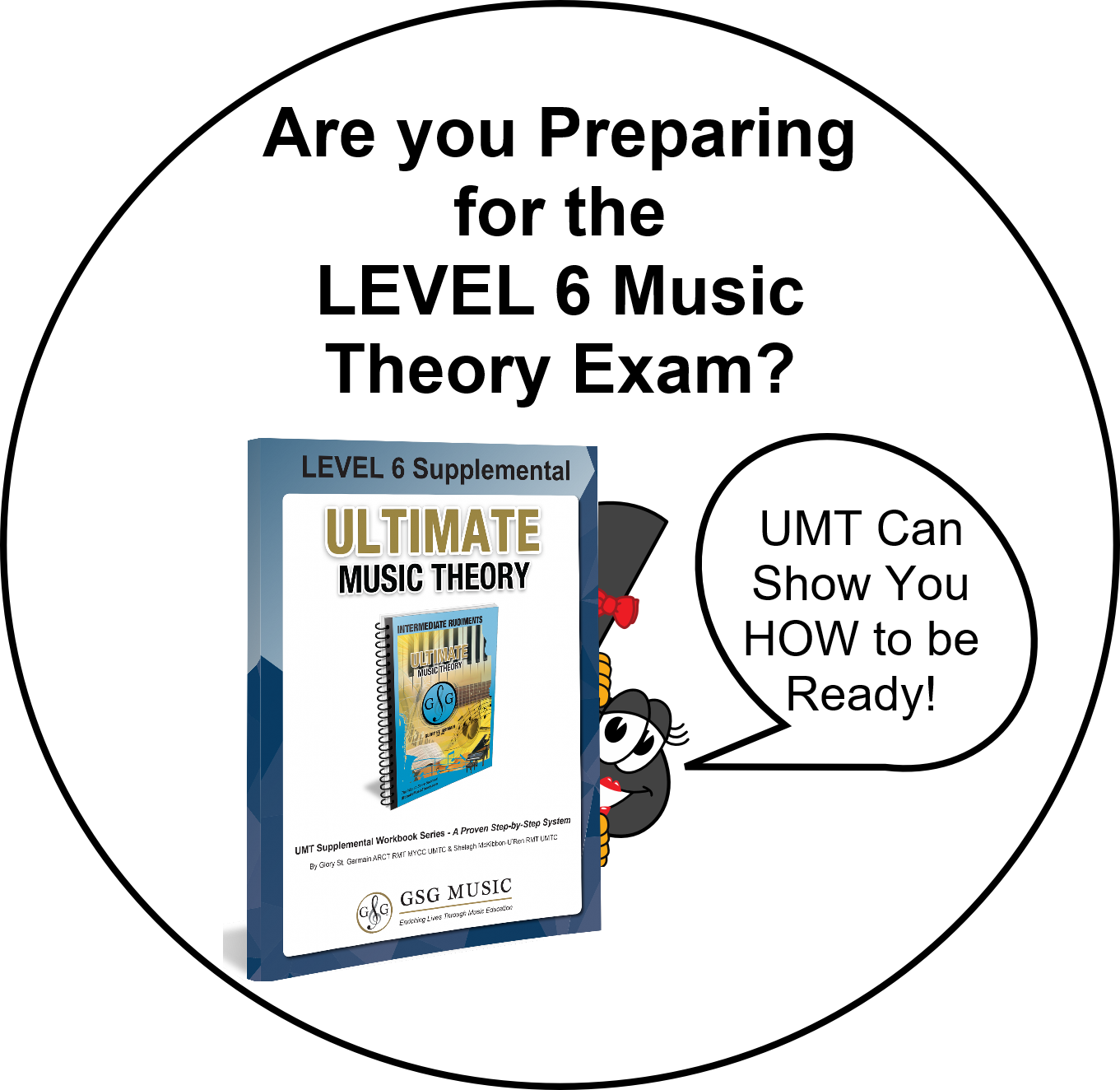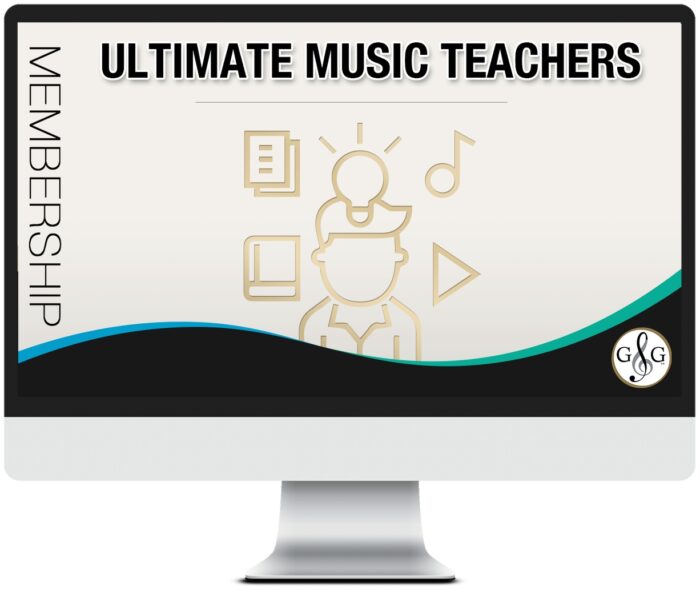Level 6 Music Theory Exam

Level 6 Music Theory Exam preparation can be a bit daunting. But don't worry - here at Ultimate Music Theory, we make it easy!
The 2016 RCM Theory Syllabus has combined the “Theory” components of the (previous) Preparatory, Basic, Intermediate and Advanced Rudiments with the Language of Harmony and History (formerly the Level 3 History and Harmony levels).
In this Blog, I will be looking at some of these “New Concepts” found in the Level 6 Music Theory Exam (formerly the Intermediate Rudiments Exam) and providing tips on how we can simplify these concepts for our students.
We will also look at how you can make certain that your students are READY to write this exam!
Level 6 Music Theory Exam - New Concept: Parallel Major and minor
In the 2016 RCM Theory Syllabus, the requirements listed under Scales include:
- All Major and minor (natural, harmonic and melodic forms) using Key Signatures and/or accidentals.
- Relative Major and minor keys (including enharmonic equivalents).
- Parallel Major and minor keys (including enharmonic equivalents).
In the RCM Exams, the students are asked the following types of questions:
Example 1: Write the enharmonic tonic minor, harmonic form of G sharp minor in the bass clef.
Example 2: Write the parallel major of C sharp minor in the treble clef.
Students and Teachers have questioned what the difference is between the use of “tonic” versus “parallel”. The term “enharmonic tonic” is not found in the Syllabus, however it is a term used in the exams.

On Page 41 of the Ultimate Music Theory Intermediate Workbook, students learn that:
- RELATIVE Major and minor scales have the SAME Key Signature. They are related.
- TONIC Major and minor scales have the SAME Tonic note. They are NOT related. Tonic Major and minor scales are also called PARALLEL Major and minor scales.
- ENHARMONIC TONIC Major and/or minor scales begin on the SAME pitch as the given key but use different letter names. They are NOT related.
- ENHARMONIC RELATIVE Major and/or minor scales begin on the SAME pitch as the relative Major or minor of the given key but use different letter names. They are NOT related.
So, in the Level 6 Music Theory Exam, here are the answers that students would be expected to write for the above examples:
Example 1: The Enharmonic Tonic minor, harmonic form, of g sharp minor = a flat minor scale, harmonic form.
Example 2: The Parallel Major of C sharp minor = D flat minor scale.
To simplify this concept, simply remind students that “Parallel Major/minor” and “Tonic Major/minor” refers to having the same “starting note” using the same “letter name” or key on the piano (with a different Major or minor tonality).
“Enharmonic” refers to having the same starting “pitch” but using a different letter name for that starting note or key on the piano. (The Major or minor tonality may be the same or different – you need to read the question.)
Here is a little Ti-Do Pop Quiz to see if you get it!

Ti-Do Tip: When Students are writing their Level 6 Music Theory Exam and they have to answer one of these "trick questions", I like to remind my students that it is OK to write the answer to the question before they write the scale.
So, in the Level 6 Music Theory Exam, if the question is: "Write the enharmonic tonic major of C sharp major in the Treble Staff", students should first figure out what that scale is going to be before they start writing it!
The answer would be the D flat Major Scale. Students can write this answer directly on their examination. (I suggest writing it in the margin beside the staff, then write the correct scale on the staff.)
Now, how did you do on the Pop Quiz? Here are the answers:

Level 6 Music Theory Exam - New “Harmony and History Concepts”:
The 2016 RCM Theory Syllabus requires the learning of “Harmony and History Concepts” beginning in Level 1 Theory. In the old syllabus, these concepts were not introduced until “Harmony” and “History” (which came after Basic, Intermediate and Advanced Rudiments).
The new concepts introduced in Level 6 Theory, and that students will need to know to complete the Level 6 Music Theory Exam, include:
Chords and Harmony:
- Dominant 7th Chords in Root Position, in close or open position.
- Identification of Authentic (V-I or V-i) Cadences and Half (I-V; IV-V or i-V; iv-V) Cadences on a Grand Staff using root position triads in Major and minor keys, in Keyboard Style.
- Application of Functional Chord Symbols (I, i, IV, iv, V, V7) and Root/Quality Chord Symbols (for example, C, Am, G7) for the implied harmonies of a melody using root position chords.
Melody and Composition:
- Composition of a Question-Answer Phrase pair (antecedent - consequent) in a Major key, given the first two measures to create a Parallel Period.
Music History - Introduction to Musical Styles of the Baroque and Classical Eras:
- Invention in C Major, BWV 772 (J.S. Bach);
- Brandenburg Concerto No. 5, BWV 1050 (J.S. Bach);
- Eine Kleine Nachtmusik (W.A. Mozart).
These new Harmony and History Concepts are taught in the Ultimate Music Theory LEVEL 6 Supplemental Workbook. There are simply too many new concepts to talk about in this blog!
Level 6 Music Theory Exam - Making it Easy!
In order to prepare for the RCM Level 6 Music Theory Examination, students should complete:
1 – The Ultimate Music Theory LEVEL 5 Supplemental Workbook (before starting the UMT Intermediate Rudiments Workbook). This will provide Students with a foundation in the new language of Harmony and History.
2 - The UMT Intermediate Rudiments Workbook AND the LEVEL 6 Supplemental Workbook. (Concepts in the LEVEL 6 Supplemental Workbook are added at specific pages in the Intermediate Workbook. These are clearly marked at the top of each page, introducing the “new” part of each theory concept when the concept is being taught.
3 – The Intermediate Rudiments Exam Series and the LEVEL 6 Supplemental Exams. Each Exam Workbook contains 4 comprehensive Theory Examinations that will thoroughly prepare students for the Theory Portion of their Examination. The LEVEL 6 Supplemental Exams (available for download with a Studio License for unlimited reproductions) provide 5 additional questions for each Exam in the Intermediate Rudiments Exam Series, and covers the new Harmony and History Concepts. There is also a BONUS Level 6 Theory Exam at the end of the LEVEL 6 Supplemental Exams. The matching Answer Books are available for both the Exam Series and the Supplemental Exams.
4 – The LEVEL 6 Practice Exam is available to download. Purchasing this exam provides teachers with a Studio License to print unlimited copies of the Exam for their Students. The LEVEL 6 Practice Exam contains questions that cover all the concepts required for Level 6 Theory (including the Harmony and History Components). To fully prepare your students for their exam, I recommend that you have your students do a MOCK EXAM. Invite them to the Studio, give them 2 hours and have them complete this Exam. You can mark the exams individually OR as a group. (Make that easy by downloading the LEVEL 6 Practice Exam Answers.)
BONUS: Use this Mock Exam "lesson" as a Make-Up Lesson (if your students missed any lessons during the year). You can also charge a "Mock Exam Group Lesson" fee, invite your students for 3 hours - 2 hours to write the exam and 1 hour to go over all answers with the students, ending with a "Term Challenge" and some Pizza!
As a Teacher, if you do not have a strong foundation in advanced rudiments and harmony, it can take some time to get used to teaching these new Theory, Harmony and History Concepts, I would strongly recommend that you work through the Ultimate Music Theory Complete Workbook AND the COMPLETE Supplemental Workbook. Mark your own work using the matching Answer Books. You will feel confident and secure in your knowledge of these new Concepts!
Ultimate Music Teachers Membership
♪ LEARN ♪ PLAN ♪ TEACH ♪ GROW
The One & ONLY Ultimate Music Teachers Membership
To Become A UMT PRO!
Your Success Path Starts Here - Go To TeachUMT.com Today!
Keep on Learning... With a Smile and a Song!
Shelagh McKibbon-U'Ren


